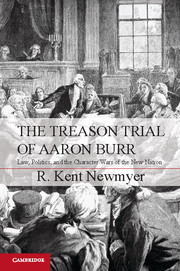Book contents
- Frontmatter
- Contents
- Acknowledgments
- Introduction
- Chronology of the Conspiracy and Associated Trial Proceedings
- Prologue A Mind-Jostling Trial
- 1 Jefferson and Burr on the Road to Richmond
- 2 Jefferson and Marshall Square Off
- 3 Legal Theater in Richmond
- 4 Treason Law for America
- 5 Judging the Judge
- Epilogue
- Index
- References
3 - Legal Theater in Richmond
Aaron Burr Front-and-Center
Published online by Cambridge University Press: 05 October 2012
- Frontmatter
- Contents
- Acknowledgments
- Introduction
- Chronology of the Conspiracy and Associated Trial Proceedings
- Prologue A Mind-Jostling Trial
- 1 Jefferson and Burr on the Road to Richmond
- 2 Jefferson and Marshall Square Off
- 3 Legal Theater in Richmond
- 4 Treason Law for America
- 5 Judging the Judge
- Epilogue
- Index
- References
Summary
“The Drama under rehearsal at the Richmond Theatre, first reported to be a Farce, is now said to be of a new species of Melo-Drama.”
Virginia Argus, June 17, 1807“…I want the jury, this audience and all the world to know and be impressed with what are the rights of the accused.”
Edmund Randolph“…two thirds of our speeches have been addressed to the people…”
George Hay to Jefferson, June 14, 1807While the president was mobilizing the nation against him in late 1806 and early 1807, Burr was setting his plans in motion in the West. Intimations of trouble came when he was twice presented to federal grand juries: first in November 1806 in Kentucky for a conspiracy to revolutionize the western states; and then in February 1807 in the Mississippi Territory, this time for fomenting secession. Both grand juries refused to indict, but Burr’s luck ran out in Mississippi. When district judge Thomas Rodney, the father of Jefferson’s Attorney General, got word of Jefferson’s proclamation, he ordered Burr to appear in court for further interrogation. Burr, aware at last that the president was out to get him, bade a hasty farewell to his young followers and headed for the woods – a wanted man with a reward on his head. He was arrested near the tiny town of Wakefield in the Mississippi Territory, taken under armed guard to Fort Stoddard and thence for several hundred miles through the southwest wilderness to Richmond, where he arrived in the evening of March 26.
Things looked bleak. He had been branded a traitor by the president he helped elevate to office and with whom he served ably as vice president for four years. A combat officer of the Revolution who served with distinction, he had been hunted down and collared like a common horse thief. He was down and out, exhausted and bedraggled. Rather than leading a victorious army into Mexico City, he entered Richmond under armed guard – the object of idle curiosity (at best) or outright hatred. On March 30, he stood before John Marshall in the Eagle Tavern for arraignment, charged with betraying the country they both fought to create. The first act of “the far famed trial” was about to unfold.
- Type
- Chapter
- Information
- The Treason Trial of Aaron BurrLaw, Politics, and the Character Wars of the New Nation, pp. 68 - 106Publisher: Cambridge University PressPrint publication year: 2012

